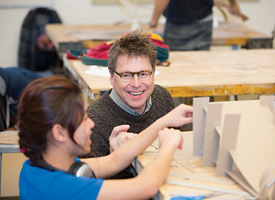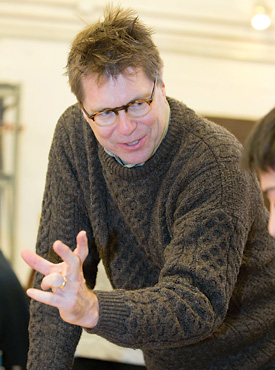Interdisciplinary course helps students tap into various aspects of creativity
So there goes Beethoven. He’s walking in the woods. Suddenly, like a bolt of lightning — BAM! He gets the idea for his Sixth Symphony. “Because he’s cool and he’s Beethoven.”
Well, not exactly, Stephen Rush explains.
“It took a lot of iterations. It took failure, it took risk over the course of time to create his work,” says the professor of performing arts technology in the School of Music, Theatre & Dance.
It’s understood that creativity is the life force behind great art, music and literature, but it also guides innovation and advancement across academic fields, he says. Rush and four other faculty members — from the College of Engineering, the Penny W. Stamps School of Art & Design, SMTD, and the Taubman College of Architecture and Urban Planning — are helping undergraduate students from many fields of study tap into their creativity through the Creative Process course.
The course doesn’t promise an answer for how to produce a great creative work. Instead, it focuses on the process of getting to a place where creativity can flow.
Ryan Achtman, a business major, art minor and junior from Walled Lake, says he appreciates that creativity is not just for artists.
“I came into the class as a ‘businessman,’ others came in as ‘musicians’ or ‘engineers’ or ‘French majors.’ But we’ll be leaving with the confidence to apply the creative process to any discipline, given an encouraging atmosphere,” he says.


Stephen Rush, professor of performing arts technology, speaks with Angel Ting, a junior from Malaysia majoring in international studies, about her Creative Process course project. Rush is one of five faculty members helping undergraduate students from many fields of study tap into their creativity through the Creative Process course. Photos by Scott C. Soderberg, Michigan Photography.
The class blends disciplines to explore sound, visual art, motion and words. Eighty students — that number has grown from 47 when the class was founded four years ago — perform activities and attend lectures and optional meditation, to cultivate creativity.
“This is a class that immerses the student into making things, that actually allows them to fail,” Rush says.
In lectures, he presents to students views on creativity through time, stated by philosophers and through the great religions, and insights on creativity in current popular culture. In workshop sessions, students take on projects that challenge them intellectually, but without the structure they’re used to. Optional meditation sessions encourage creative thought from another direction.
Their final project calls on them not to present a great creation — a song, dance, building or concept. Instead, they must demonstrate what they’ve learned about the creative process.
“If they have made a good, hard investigative effort and worked at problem solving, they’re going to do well,” says Elona Van Gent. The professor of art in the Stamps School is among the faculty who present class elements.
Rush stresses that he and fellow faculty members aren’t the only sources of direction or inspiration for the group.
“Students learn a lot about the creative process by looking at their peers, and by seeing them struggle they see we’re all kind of on a lateral plane. We’re all creative people. We can write poetry, we can dance — maybe not so well — but according to whose standards? Ultimately it’s a journey of self celebration. You discover who you are in a creative way and let that emerge,” he says.
Guiding creativity
On the surface, it appeared to be a light, class-related exercise. That’s when Rush earlier this semester threw handfuls of red, blue, pink, yellow and green balloons over a second floor railing at the Art and Architecture Building to students clamoring below.
Inside each balloon had been placed a piece of paper with a unique guide word. The word or concept — such as “Swiss Army knife” or “yellow” — is used to inspire a student’s final project.
A few weeks later, a different set of guide words direct the actions and creative decisions of a half dozen Creative Process students, perched on stools set around a work table. In this workshop course element, students use a few basic materials — cardboard, box cutters, glue and tape —to create three-dimensional representations of their words.
Nate Slottow, a senior from Ann Arbor, surveys a landscape of cardboard pyramids he has made, of varying sizes. “My prompt was ‘rhythm.’ I like music and I was thinking of the different patterns and ratios in music,” he explains.
The computer engineering major says he likes the class and what he’s learning about creativity. His biggest insight: “It’s more of a process and not a rush to get something done.”
In a Duderstadt Media Gallery workshop session led by Van Gent, students sitting at laptops are asked to make collages of images manipulated with Photoshop. Elizabeth Jabaay, a Grand Rapids sophomore in LSA, chooses a dolphin with a dress and flamingo legs. “I thought it would be interesting to give it a heavier top by giving it a dolphin body,” she explains. “I’m learning more about trial and error with creativity. You just keep trying different things until it works.”
Jabaay says that as the class works across disciplines including sound, engineering, and art and design, she’s learning more about finding inspiration. “You can find art and creativity in anything and being creative is helpful in making new products and in your business because without new ideas we would just stand still,” she says.
Aakash Jobanputra, a Scarsdale, N.Y., junior majoring in economics, says, “It’s a very different class. In most classes I have a straight goal — you do this, this and this. But here you create a cool project and really have to discover yourself.”
Jobanputra, who is creating a social networking platform devoted to nightlife, adds that classwork is focused on problem solving. He says this helps him build confidence to deal with issues in his startup venture.
Mark Kirschenmann, lecturer of jazz and contemporary improvisation, and lecturer in the Residential College, opens his Creative Process class session by asking students to name known risk takers in their preferred field of study. He says taking risks — and failing — is crucial to exploring the creative process. As an example, Kirschenmann tells the group he admires Miles Davis for following his heart and changing his musical style so drastically that some old fans abandoned him.
Achtman tells the class he chose the example of Steve Jobs: “He morphed business together with art, he combined design and technology together, which was really cool.”
Soon, Kirschenmann is pulling out his trumpet and fingering the keys. Before playing a brief improvisation, he asks students to draw what they hear. “There aren’t any mistakes to be made. What you’ll see is everyone has come up with their own right answer,” he says. Tonique Brown, a women’s studies and English major from Detroit, draws a series of large dots and half circles along the edge of the paper. She is the first to place her finished drawing on Kirshenmann’s black music stand. “It’s life at play,” she says.
Flaky-baky?
Through the lecture element of the course, Rush seeks to present the history of creativity from a social point of view.
“Meister Eckart (an early German theologian) had reasons for being creative, mostly having to do with making the world a better place, in whatever way that makes sense. It could be about healing other people or healing the planet,” Rush says.
He lectures on views of creativity presented in the Bhagavad Gita, the Chinese Dao De Jing, from Buddhism, and from early mystical Christianity. “They looked at God as a creator first. There’s an ethic of, ‘Go ahead and make stuff — God does,’ ” he says.
Rush says the broader benefits of getting students to study the creative process are measureable. “There are a lot of questions about the structure of a course like this. People want to know, does it pay off, really? It’s kind of flaky-baky, outcomes are somewhat indiscernible, there’s not a lot of course content like in a physics course.
“But when we tested the students the first couple of years, their sensitivity to diversity, which can be measured, is up significantly. That’s because these students develop an ability to listen to people who are not you. If your guide word is yellow, you have to listen to other students say, ‘Here’s what I think of when I think of yellow,’ and then you have to listen to faculty weighing in on yellow,” Rush says.
Students learn that while there may be different views of what yellow is, all of the perceptions hold truth. That, Rush says, leads students to conclude that there are different truths being represented in different systems and cultures at the same time.
Through optional meditation sessions, students are asked to clear their thoughts, to make way for new ones. “You’ve got to let that land lie fallow or it’s going to dry up on you,” Rush says. He adds that research on meditation finds the practice boosts compassion, which plays a role in creative social transformation.
In the lecture session, Rush also talks of meditation — not the kind practiced traditionally, but applied during a routine task — such as waiting in line at the grocery store. “You might look around and say you’re the old guy in the front of the line who can’t find his checkbook. What if you are them and they are you? It’s a great opportunity to have these different perspectives. Just take it in, man,” he says.
Getting it
How do faculty determine if students are actually getting the creative process? Van Gent says students demonstrate by asking questions, developing ideas, going through iterations, and trying out changes. “If they’re doing that kind of thing, then they’re engaging in the creative process,” she says.
Students’ final projects are portrayed in semester-ending gallery displays. Because some final projects are conceptual, this can be a challenge.
“We’ve had results that have been as strange and interesting as a student reliving a day in his life as a 5-year-old,” Rush says. One student’s final project involved making a friend with an older woman in a nursing home. Another student made a perfume based on William Wordsworth’s poetry. Then there was the student who drew the prompt word “hand.” Rush says the student visited a palm reader, and made a 3-foot-long puzzle of his hand.
“You can see an exploration of identity by abstraction as well,” Rush says. “But we don’t really care in a certain sense what the outcome is, it’s more about the process.”
Faculty who teach the course all report it has an effect on students, often profound. One student’s final project inspired his master’s thesis. Many students offer feedback after the class is over. “They talk about the confidence they gained form the course, the sense of problem solving as a process rather than just sitting and waiting around for an idea,” Van Gent says.
Rush says it’s not unusual for Creative Process faculty to get messages from past students who say the class changed their lives. In some cases this has meant changing a major. Others include the student who chose to spend a summer in a remote village in Peru, teaching young children to read and do simple math. This was inspired by Rush’s suggestion through the course to do what you love.
“For many reasons, this class is a safe place to explore sense of purpose and dreaming,” Rush says.

